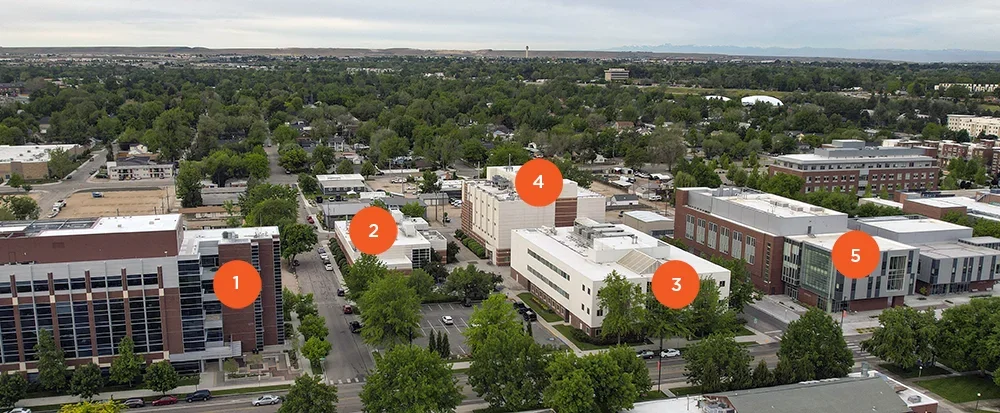Explore FaCT Core Capabilities
The College of Engineering houses the Fabrication, Characterization, & Testing (FaCT) Core. It is our primary service facility for researchers, and a central part of the Convergent Engineering and Biomolecular Science Center of Biomedical Research Excellence (CEBS COBRE) (more on this below). Click the drop downs to learn about capabilities, services, and rates in its four units:
Biomechanics and Mechanobiology (BMMB)
The BMMB offers a variety of equipment to support cell biology and mechanotransduction experiments, including a cell culture suite, strain bioreactor, custom clinostat system for simulated microgravity studies of adherent cells, micro computed tomography X-ray scanner, confocal microscope, and a combined atomic force/confocal microscope system equipped with a thermal stage and gas perfusion for simultaneous co-localized nanomechanical and optical characterization of live cells and tissues. Visit the BMMB website for more details and to see rates.
Boise Center for Materials Characterization (BSCMC)
The BSCMC provides equipment and expertise to enable materials characterization through the two laboratories summarized below. Visit the BSCMC website for more details and to see rates.
- The X-ray and Electron Microscopy Laboratory (XEML)—Equipped with a TEM, FE-SEM with EDS and EBSD, an electron microprobe (EPMA), XRD, XRF, and optical microscopes, it offers a comprehensive suite of advanced materials characterization tools for structural, microstructural, and chemical analysis at the nanoscale. The lab also provides robust sample preparation capabilities for both optical and electron microscopy.
- The Surface Science Laboratory (SSL)—Houses a suite of four atomic force microscopes (AFMs) with complementary capabilities for nanoscale characterization of surface topography and electrical, magnetic, mechanical, thermal, and electrochemical properties of materials in an inert argon atmosphere glovebox, ambient air, or fluid. An AFM-IR/s-SNOM system additionally enables nanoscale chemical analysis.
Idaho Microfabrication Lab (IML)
The IML offers both cleanroom and additive manufacturing services. Operating as both an instructional lab and research space, you can use it to teach semiconductor processing concepts, conduct user research, and develop proof-of-concept designs and/or rapid prototypes. Visit the IML website for more details and to see rates.
- A traditional Class 100 semiconductor cleanroom is complete with thin film deposition, wet and dry etch, chemical and thermal processing, and photolithography tools for microelectronics
- Additive manufacturing capabilities include ink jet, aerosol jet, and extrusion printers for flexible and hybrid electronics, plus associated characterization and metrology tools.
Research Machining and Engineering (RME)
The RME is a fee-for-service group that offers a broad range of expertise to troubleshoot, modify, repair, and fabricate engineered solutions that support campus research. An engineering professional, electrical and mechanical technicians, a professional machinist, and undergraduate students specialize in mechanical design, current design feedback, electrical and mechanical repair, and fabricating metal and/or plastic components such as custom fixtures and sample holders. Visit the RME website for more details and to see rates.
Research Facility Locations
College investigators conduct research across several buildings—centrally the five campus buildings shown in the image below. Laboratories are also located across campus in the Multipurpose Classroom building (MPCB), in the Yanke Family Research Park (YFRB) along the Boise River, and in downtown Boise in both City Center Plaza (CCP) and the U.S. Bank Building. For addresses and directions, search by building code or name on the Campus Map.

- Environmental Research Building (ERB)
- Harry Morrison Civil Engineering (HML)
- Charles P. Ruch Engineering (RUCH)
- Micron Engineering Center (MEC)
- Micron Center for Materials Research (MCMR)
Centers
The college provides oversight in whole or in part over three centers, the:
- CEBS COBRE—Grows regional biomolecular research capacity, specifically focused on biomedical devices, sensors, and systems for basic biomedical research or clinical applications
- Center for Atomically Thin Multifunctional Coatings—Develops novel coatings and functionalities enabled by two-dimensional materials
- Microelectronics Education and Research Center (MERC)—Works with the university community, regional industry, and international partners to expand microelectronics and semiconductor education, research, and manufacturing
CEBS COBRE
The Convergent Engineering and Biomolecular Science Center of Biomedical Research Excellence advances regional biomedical research and clinical applications that use biomedical devices, sensors, and systems. The National Institutes of Health funds this university center, with a director / principal investigator (PI) from the College of Engineering, and an associate director / co-PI from the College of Arts and Sciences.
Its Fabrication, Characterization, and Testing (FaCT) Core research facility is also the primary service facility supporting the campus community and external collaborators.
Contact: Jim Browning
Center for Atomically Thin Multifunctional Coatings
This national university, industry, and government partnership expands industry innovation by creating novel coatings from two-dimensional materials, with unique physical, optical, electrical and chemical properties. National Science Foundation and industry funding advance energy, healthcare, accessibility, space exploration, and environmental solutions.
Penn State University leads. Boise State contributes expertise in additive manufacturing of electronics, atomic layer deposition, and scanning probe microscopy.
Of particular note is an Aixtron metal organic chemical vapor deposition (MOCVD) tool for wafer-scale 2D materials synthesis, the only one of its kind at a US university.
Boise State Contact: David Estrada
Microelectronics Education and Research Center
A central hub for microelectronic innovation, entrepreneurship, and workforce development in Idaho, MERC works with the university community, regional industry, and international partners to expand microelectronics and semiconductor education, research, and manufacturing.
The center offers facilities, programs, and resources that forge connections between K–12 classrooms, university education, and the workforce to raise awareness of microelectronics, and build a workforce pipeline. MERC also helps facilitate opportunities for college students to work closely with faculty on leading-edge research, and to prepare for related careers.